The strange and curious pantheon of biblical gods and monsters (part 3)
Ok, we are continuing our journey through the wonderful and curious world of biblical monsters - they are lurking everywhere!
Tannin (תַּנִּין) - translated as either a "dragon", a "whale" or "crocodile", the identity of this creature, like the Leviathan or the Behemoth, has been the source of unending speculations and debates among scholars. Tannin first rears its bizarre head at the very beginning of the Hebrew Bible - Genesis 1.
"And God created great whales [Tannin] and every living creature that moveth, which the waters brought forth abundantly..." (Genesis 1:21).
Most newer translations are not so committed to the 'whale' idea and render Tannin simply as 'sea creatures'. In certain contexts the word can mean a serpent -
"And Moses and Aaron went in unto Pharaoh, and they did so as the LORD had commanded: and Aaron cast down his rod before Pharaoh, and before his servants, and it became a serpent [Tannin]". (Exodus 7:10).
I think the Pharaoh would have been really impressed if Aaron's rod turned into a whale, but that's just my opinion.
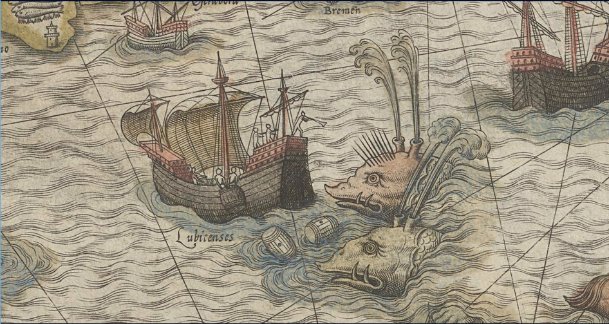
Illustration from Olaus Magnus’s 1539 Carta Marina displaying dragon-whales
What do you get when you combine a whale and a serpent? That's right - a dragon!
"In that day the LORD with his sore and great and strong sword shall punish leviathan the piercing serpent, even leviathan that crooked serpent; and he shall slay the dragon [Tannin] that is in the sea." (Isaiah 27:1)
This verse had already come up in Part 1 in connection with the Leviathan and so the context surely warrant a reference to something more than just a whale or a serpent. Yahweh seems to have a perennial grudge against the large animals he himself had created. Moreover, Job complains to God, "Am I a sea, or a whale [Tannin], that thou settest a watch over me?" (Job 7:12) It appears that God has some kind of surveillance program going on in connection with the Tannin - a Global Whale Positioning System. Tanninim (plural of Tannin) are encouraged to submit to God's pre-eminence and join in his worship... or else!
Just like with the Leviathan, the Tannin hearkens back to the taming of the Sea (see Yam) by the Semitic Baal. It is order vs. chaos, Land vs. Sea, Ahab vs. Moby Dick type of struggle, and it's right there in the Bible. And it is by no means an isolated occurrence - "Thou didst divide the sea by thy strength: thou brakest the heads of the dragons in the waters" (Psalm 74:13) Incidentally, the Greek translation of the Hebrew Bible, the Septuagint (or LXX), also favors the "dragon" or "sea serpent" as a suitable counterpart of the Tannin - τὰς κεφαλὰς τῶν δρακόντων ("tas kefalas ton drakonton" - "the heads of the dragons"); this is useful to us in that it furnishes a historical understanding of Tannin by the Jewish Alexandrian scribes around 250 BCE.
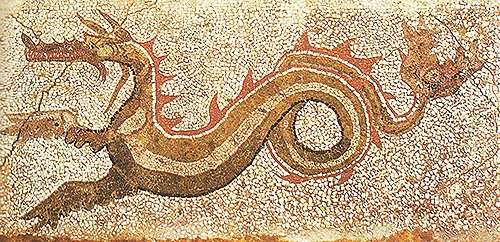
Ancient Greek mosaic from Caulonia, Italy depicting a cetus or sea-dragon
In an even wilder twist of linguistics, some scholars have suggested that the Hebrew "tannin" made its way into the Greek θύννος("tunnos" - lit. "large fish") from which we get our English word for "tuna". So, next time you order a tuna sandwich, remember the Tannin of the deep!
Rahab ( רַהַב ) - this is not the Rahab which helped the Israelites to destroy Jericho, in fact, this is not a human being at all.
"Awake, awake, put on strength, O arm of the LORD; awake, as in the ancient days, in the generations of old. Art thou not it that hath cut Rahab, and wounded the dragon?" (Isaiah 51:9)
The reference to the "ancient" time frame and "wounding the dragon" (see Tannin above) makes it clear that Rahab is in fact a monster-type creature. The etymology of the word is unclear, possibly related to a Hebrew root which means "to assail", and may be related to the Akkadian ra'abu(m) - "tremble with fear or rage". In fact, scholars describe Rahab as a chthonic chaos monster - similar to the Titans or the Hekatonheires in Greek mythology. In both cases the nascent authority figures - Yahweh and Zeus - are portrayed as taming the chaotic (see Yam) and destroying or confining the otherwise defiant chthonic forces. "He quieted the sea with His power,And by His understanding He shattered Rahab" (Job 26:12, New American Standard Bible).
Like every self-respecting monster, Rahab has an entourage - "God will not turn back his anger; beneath him bowed the helpers of Rahab." (Job 9:13, RSV). References to the cosmic battle between Yahweh and sea monsters like Rahab display close parallels with Baal and his battle against the god of the Sea (Yam).
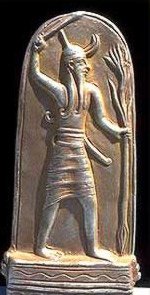
Baal striking sea god Yam
Yam (יָם) - literally translated "sea", Yam is also the name of the Ugaritic deity of the sea and an arch-enemy of Baal. If you had followed the discussion in Part 1 on El/Yahweh dichotomy and the hypothesis that Yahweh is a Hebrew replacement for the more archaic Baal, the following verses in the Hebrew Bible start to make a whole lot more sense:
"You destroyed the sea [Yam] by your strength; you shattered the heads of the sea monster in the water. You crushed the heads of Leviathan; you fed him to the people who live along the coast." (Psalms 74:13-14).
There is really no pressing reason for God to dislike the sea or its creatures if he is the omnipotent creator; however, if the deity is based on an older Ugaritic concept of a balance of divine powers among Baal and Yam, then the motives for God's continual "taming" of the sea become more transparent. "...the LORD [Yahweh] hath his way in the whirlwind and in the storm, and the clouds are the dust of his feet. He rebuketh the sea, and maketh it dry..." (Nahum 1:4) Baal-style epithets of storm and whirlwind (Baal is known as the storm god) are followed with Baal-like aversion for his old enemy - the Sea.
In cultic Ugaritic literature Yam is pictured as the seven-headed monster, a fierce emissary of chaotic forces of nature (see below).
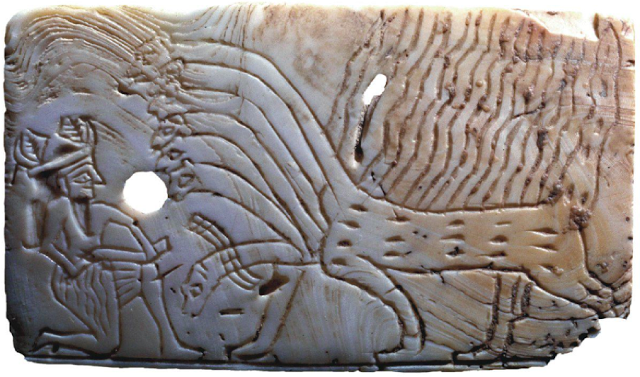
Ugaritic god battling seven-headed fire-breathing sea monster
Mot (מָוֶת) - lit."death". Just like Yam, which literally means "sea", the word "Mot" used to be a proper noun, denoting a Canaanite deity, a demon of death, but has later undergone de-personification (a reverse process of the hypothetical rise of religious sentiment where natural phenomena are personified and deified). Thus, most occurrences of Mot in the Bible speak of the literal phenomenon of death. However, some of the more archaic poetic references hint at the rich connotative semantics of the word. For instance, in Job 18:13 Death is described as having a son (a firstborn!), and in the Psalms Mot is presented as the "other" Good Shepherd -
"Like sheep they[mankind] are appointed for Sheol; Death shall be their shepherd; straight to the grave they descend, and their form shall waste away; Sheol shall be their home." (Psalm 49:14, Revised Standard Version).
In later prophetic utterances Mot is clearly described as a personal active being that even has a certain character flaws (insatiability):
"For death [Mot] is come up into our windows, and is entered into our palaces, to cut off the children from without, and the young men from the streets." (Jeremiah 9:20)
"Wealth is treacherous, and the arrogant are never at rest.They open their mouths as wide as the grave, and like death, they are never satisfied." (Habakkuk 2:5, New Living Translation)
This last reference is especially revealing because in the Ugaritic texts Mot is described as an insatiable consumer of gods and men as follows - "A lip to the earth. a lip to the heavens, ...a tongue to the stars! Baal must enter his stomach, Go down into his mouth". Clearly, Mot is another one of Baal's nemeses (N.B.: Baal is considered as one of the prototypes of Israel's Yahweh). Thus Yahweh's promise should come as no surprise - "He [Yahweh] will swallow up death in victory" (Isaiah 25:8). Instead of being eaten by Mot, Yahweh himself swallows him up.
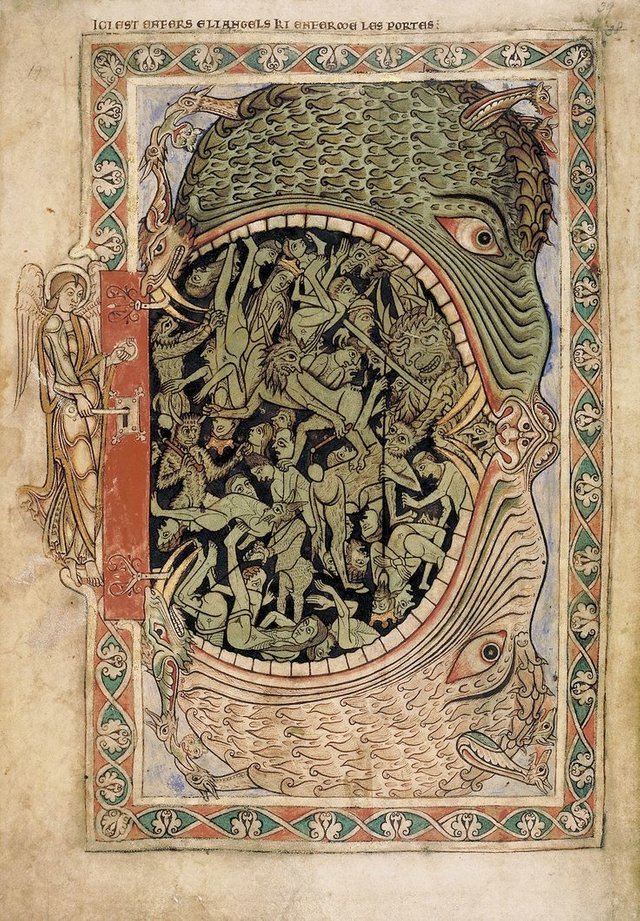
Death presented as "swallowing up" the sinners. From Winchester Psalter manuscript. Winchester, England
Given this state of animosity, Yahweh is quite displeased when his people make side business deals with Mot:
"Because ye have said, We have made a covenant with death [Mot], and with hell are we at agreement; when the overflowing scourge shall pass through, it shall not come unto us: for we have made lies our refuge, and under falsehood have we hid ourselves..." (Isaiah 28:15)
It must be noted that while a direct link between "Death" of the Hebrew Bible and Mot of Ugaritic tradition may be tempting, not all scholars favor this interpretation, positing instead the usage of mere poetic literary devices that provide metaphorical comparisons between dying and being devoured by a savage god. In any case, the medieval tradition had clearly espoused the more personal and vivid view of death as a monster, as exemplified by the illustration presented below.
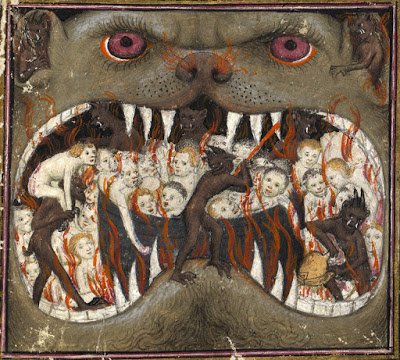
Mouth of hell. Thomas de Saluces, Le Chevalier errant, Paris ca. 1403-1404.
Tiamat/Tehom (תְּהוֹם) - lit."the Deep" occurs throughout the Hebrew Bible, starting with the creation story in Genesis 1:2 - "and the earth was without form and void, and darkness was upon the face of the deep [Tehom]". The word "Tehom" is etymologically related to Akkadian "Tiamat" - a well-known goddess from the Babylonian creation story "Enuma Elish" where Tiamat is portrayed as the personified primeval ocean defeated by Marduk, who then establishes his supremacy. The same motifs of Yahweh battling the Sea (Yam) and taming the Deep (Tehom) are prevalent in the Bible.
Because Tehom is mentioned mostly in the poetic literature, it is not entirely clear whether these are allusions to a more archaic echoes of Tiamat or simply metaphors employed by the authors to communicate their ideas. In any case the allusions are quite beautiful and thought-provoking:
But where shall wisdom be found? and where is the place of understanding?...The depth [Tehom] saith, It is not in me: and the sea [Yam] saith, It is not with me. (Job 28:12,14)
"The waters saw thee, O God, the waters saw thee; they were afraid: the depths [Tehom] also were troubled." (Psalm 77:16)
"Deep [Tehom] calleth unto deep [Tehom] at the noise of thy waterspouts: all thy waves and thy billows are gone over me." (Psalm 42:7)
The parallels between Tehom and Tiamat become more compelling when one studies the Babylonian account of the Flood in the Epic of Gilgamesh and compares it with the creation stories in Enuma Elish and Genesis. In Enuma Elish (IV 139-140) Tiamat is killed and her body becomes the separation point for the cosmic waters tied up inside her using posts and guards. According to the Epic of Gilgamesh (X,101), the Flood occurs because the posts get broken. This is very similar to the Geneses 1 and 6 accounts of the "firmament" that was erected to separate the celestial waters from the subterranean waters, and the subsequent description of Noah's Flood when "all the fountains of the great deep [Tehom] were broken up" (Genesis 7:11). The corresponding details are too compelling to ignore. It is thus entirely plausible to suggest that Tehom represents a de-mythologized cultural echo of the Babylonian Tiamat.
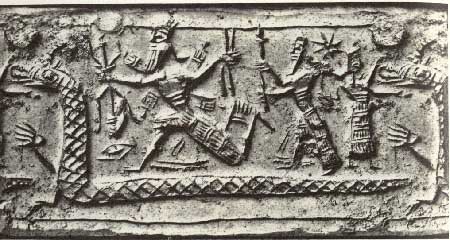
Marduk destroying Tiamat, who is here represented in the form of a huge serpent. From a seal-cylinder in the British Museum. [No. 89,589.]
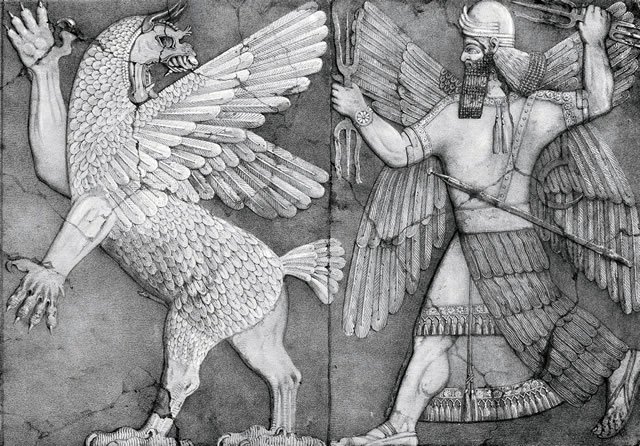
Marduk battles Tiamat. Drawn by Faucher-Gudin from the bas-relief from Nimrûd preserved in the British Museum.
This is it for now, folks! In the next and final edition of this series we will look at the book of scary stories you should not read before going to bed - the Psalms (well, at least one of them). There we will find some more biblical monsters for our consideration.
Bibliography
Dictionary of Deities and Demons in the Bible. Edited by Karel Van Der Toorn, Bob Becking and Pieter W. Van Der Horst. Leiden: Brill/Grand Rapids: Eerdmans. 2nd ed., 1999.
Kulik, Alexander. How the Devil Got His Hooves and Horns: The Origin of the Motif and the Implied Demonology of 3 Baruch. 2013. Numen 60 (2013), 195-229.